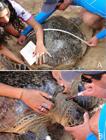Biomarkers can be used in a predictive manner, permitting actions control to be taken before they occur irreversible damage with severe environmental ecological consequences, however, sentinel species are needed to evaluate these markers. Sea turtles affected by fibropapillomas are considered sentinel species, signaling the marine environmental imbalance in their areas of occurrence. With the objective to use the plasma cholinesterase activity in green turtles (Chelonia mydas) as a biomarker, the measurement of enzyme activity was evaluated in healthy animals and in location of low pollution impact (Fernando de Noronha, Pernambuco, Brazil) to serve as a reference for comparison with animals trapped in places with higher pollution impact. Were analyzed heparinized plasma samples from 35 captured animals. All samples analyzed showed enzymatic activity of plasma cholinesterase. The values obtained ranged between 162-379 IU/L, with mean and standard deviation of 216.4 ± 51.4 IU/L. In studies of repeatability and reproducibility were obtained variance coefficients of less than 5% in all analyzes, so the analytical methodology proved successful. The longevity of marine turtles of the species C. mydas, feeding behavior, along with the fact possess detectable enzyme activity may indicate this species as a bioindicator of exposure to pollutants that influence plasma cholinesterase activity
Biomarkers; green turtle; Chelonia mydas; cholinesterase

 Thumbnail
Thumbnail
 Thumbnail
Thumbnail



